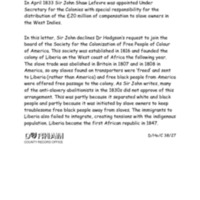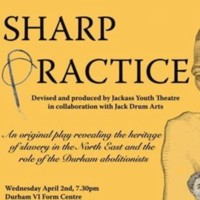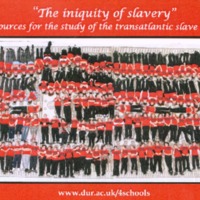
Exhibition to mark the bicentenary of the 1807 Act
Durham Record Office held an exhibition of its original documents relating to slavery, the slave trade and abolition. These include reports, maps, and a number of letters, from, for example, Sir John Shaw Lefevre (Under Secretary for the Colonies in 1833), the abolitionist James Stephen and the prominent Quaker activist Josiah Forster. The exhibition was displayed in the Record Office and toured several venues in the region. It was also used for inspiration by members of Jackass Youth Theatre, who produced the play Sharp Practice after visiting the Record Office and consulting some of the original documents on display.

Sharp Practice
Inspired by archival research, ‘Sharp Practice’ was a touring play exploring the slave trade and the role of abolitionists from the North East of England in its demise (and, in particular, the work of Granville Sharp). The play was devised and produced by Jackass Youth Theatre, in collaboration with professional artists from Jack Drum Arts. Each performance was accompanied by an exhibition exploring the North East’s links to slavery and abolition, researched by members of the theatre group. Working with heritage professionals, their research took the performers to Newcastle, Hull, Liverpool, Gloucester, London and the University of Virginia.

The Iniquity of Slavery
Durham University Library holds many archives relating to the slave trade in its Special Collections due to a connection with the family of abolitionist Granville Sharp. This is supplemented by material relating to the West Indies and the slave trade in the papers of the Prime Minister between 1830 and 1834, Charles Grey, 2nd Earl Grey. This material had already been used in a series of online resources available to download on the 4schools website. Central to their bicentenary commemorations in 2007 was a special event to recreate the image of the slave ship ‘Brookes’ using a life-size print of the middle deck and populating it with nearly 300 students from local schools. Students were also given the opportunity to learn African dance and drumming. The handling collection, print and resources produced as a result of this event are still in use for outreach work with local schools.